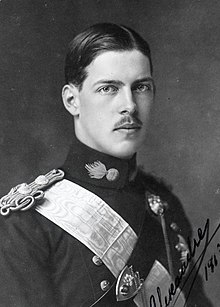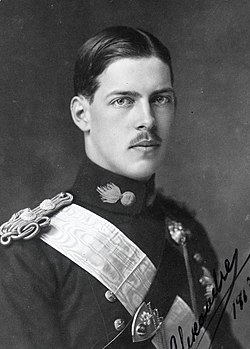Alexandr I. Řecký
| Alexandr I. | |
|---|---|
| král Helénů | |
 Alexandr I. před rokem 1920 | |
| Doba vlády | 1917–1920 |
| Narození | 1. srpna 1893 palác Tatoi, Athény, Řecko |
| Úmrtí | 25. října 1920 (27 let) Athény, Řecko |
| Pohřben | Královský hřbitov, palác Tatoi, Řecko |
| Předchůdce | Konstantin I. Řecký |
| Nástupce | Konstantin I. Řecký |
| Manželka | Aspasia Manuová |
| Potomci | Alexandra Řecká a Dánská |
| Rod | Oldenburkové |
| Dynastie | Glücksburkové |
| Otec | Konstantin I. Řecký |
| Matka | Sofie Pruská |
| Podpis | |
| Některá data mohou pocházet z datové položky. | |
Alexandr I. (řecky Αλέξανδρος, Βασιλεύς των Ελλήνων; 1. srpna 1893, Athény – 25. října 1920, Athény) byl řeckým králem vládnoucím v letech 1917 až 1920.
Byl dosazen na trůn v době takzvaného Národního rozkolu, během něhož se střetli Alexandrův otec Konstantin I. a řecký předseda vlády Eleftherios Venizelos. Za pomoci vojáků Dohody dosadil Venizelos na trůn mladého prince Alexandra, který však o tři roky později zemřel na následky pokousání dvěma opicemi.
Mládí
Narodil se 1. srpna 1893 v Tatoi poblíž Athén. Byl druhým synem Konstantina I. a jeho manželky Sofie Pruské.
Vláda

Roku 1917 tehdejší řecký král Konstantin I. trval na tom, aby Řecko zůstalo během první světové války neutrální, avšak premiér Eleftherios Venizelos byl rozhodnut zapojit se do války na straně Trojdohody. Na základě Venizelova pozvání během takzvaného Národního rozkolu vstoupily francouzské a britské jednotky na řeckou půdu a donutily Konstantina abdikovat. Ten poté se starším synem princem Jiřím odešel do exilu. Mladý princ Alexandr, zastánce ideje Velké myšlenky, poté usedl na trůn jako Alexandr I. Alexandr neměl téměř žádnou moc a jeho jedinou významnou povinností bylo časté navštěvování fronty a povzbuzování řeckých jednotek.[zdroj?]
Přesto se při jedné příležitosti Alexandr Venizelovi vzepřel. 4. listopadu 1919 utekl s Aspasií Manuovou (1896–1972), dívkou nešlechtického původu a dcerou plukovníka Petrose Manose, čímž způsobil skandál a rozzuřil Venizela. Aspasia byla donucena opustit Athény, dokud se krize nevyřeší, a jejich svatba byla uznána bez oficiálního uznání Aspasie královnou. Místo toho byla nazývána Madame Manos. O šest měsíců později mladý pár odjel do Paříže. Museli ovšem dodržet podmínku, že spolu nebudou cestovat ani vystupovat při oficiálních příležitostech.[1]
Brzo poté byla podepsána v srpnu 1920 Sèvreská smlouva, která byla pro Řecké království velmi výhodná. Řecko získalo rozsáhlá území v Thrákii a v oblasti kolem Smyrny v dnešním Turecku. Alexander se stal králem mnohem většího řeckého státu, než byl doposud.[2]
O několik měsíců později však Alexander 25. října 1920 umírá na následky otravy organismu. Ta byla způsobena dvojicí opic, které zaútočily na Alexandrova psa. Král se snažil svého mazlíčka bránit a opice pokousaly i jeho.
Po sobě nechal manželku Aspasii a dceru Alexandru, která se narodila po jeho smrti. Té byl později přiznán titul princezny řecké a dánské. Alexandra si vzala Petra II., posledního jugoslávského krále.
Vývod z předků
Odkazy
Reference
V tomto článku byl použit překlad textu z článku Alexander of Greece (king) na anglické Wikipedii.
- ↑ VAN DER KISTE, John. Kings of the Hellenes. Stroud, Gloucestershire, Anglie: Alan Sutton Publishing, 1994. Dostupné online. ISBN 0-7509-0525-5. S. 119. Dále jen [Van der Kiste].
- ↑ Van der Kiste, str. 120
Související články
Externí odkazy
 Obrázky, zvuky či videa k tématu Alexandr I. Řecký na Wikimedia Commons
Obrázky, zvuky či videa k tématu Alexandr I. Řecký na Wikimedia Commons - Genealogie Leo van de Pas
| Předchůdce: Konstantin I. Řecký | král Řeků 1917–1920 | Nástupce: Konstantin I. Řecký |
Média použitá na této stránce
Coat of arms of the Kingdom of Greece in 1936–1973
- Royal Coat of Arms of Greece under the Glücksburg dynasty, created after the restoration of King George II to the throne in 1935, to the exile of King Constantine II in 1967 and finally until the abolition of the monarchy in 1973.
- The Escutcheon features the white cross on a dark blue field of Greece. The Inescutcheon features the Arms of the Greek line of the House of Schleswig-Holstein-Sonderburg-Glücksburg. The shield is then topped with a golden Royal Crown.
- It features an escutcheon divided by the red and white cross of the Order of the Danneborg, the first quarter features the arms of Denmark (three crowned blue lions and nine hearts in yellow field). The second of Schleswig (two blue lions passant in yellow field). The third divided into four; the chief features the three royal crowns in blue field of the Kalmar Union, the second half with a crowned stockfish on red field of Iceland and the last half divided between the ram of the Faroe Islands and a polar bear of Greenland, both on blue fields. The fourth quarter is divided between two halves, the chief depicts a yellow field with a blue lion passant over nine red hearts of the King of the Goths, the lower half depicts a crowned golden lindorm on a red field of the King of the Wends.
- Upon it is another inescutcheon in red, divided into four quarters: the first a a silver nettle leaf of Holstein, the second the a swan with a golden crown of Stormarn, the third a knight dressed in golden armor on a silver horse of Dithmarschen and the fourth of a golden horse's head of Lauenburg.
- Upon it is another inescutcheon divided the first features the red and yellow bars of Oldenburg, the second a golden cross on a blue field of Delmenhorst.
- The escutcheon rests on a golden pedestal and supported by two human figures representing the Greek mythological hero Herakles (Heracles), holding a wooden club and wearing the skin of the Nemean lion.
- The escutcheon is surrounded by the ribbon and cross of the Order of the Redeemer, the cross depicts Christ Pantocrator, surrounded by the order's motto:"Η ΔΕΞΙΑ ΣΟΥ ΧΕΙΡ, ΚΥΡΙΕ, ΔΕΔΟΞΑΣΤΑΙ ΕΝ ΙΣΧΥΙ" or "Thy right hand, O Lord, is become glorious in power" from Exodus, 15:6.
- The motto of the Coat of arms and of the dynasty, depicted on a golden ribbon below the pedestal reads: "Ἰσχύς μου ἡ ἀγάπη τοῦ λαοῦ" or "The people's love, my strength"
- The coat of arms is then surrounded by a dark blue mantle and topped with another royal crown.
The signature of King Alexander I of Greece. From a decree signed for a pension to the mother of a fallen Greek soldier.
Autor: Di (they-them), Licence: CC BY-SA 4.0
Royal arms of Denmark from 2024, based on information from https://www.kongehuset.dk/en/the-monarchy-in-denmark/the-royal-symbols/the-royal-coat-of-arms/# (image).
Autor:
- Royal Coat of Arms of Greece (1863-1936).svg: Sodacan
- derivative work: Sodacan (diskuse)
Coat of arms of the Kingdom of Greece from 1863- 1936
- Arms of Greece under the Glücksburg dynasty, created in 1863 for the new Glücksburg monarchy of Greece under King George I (Prince William of Denmark), used until 1924 when the King George II was exiled, until 1936 when the arms was replaced by a New version.
- The Escutcheon features the white cross couped on a light blue field of Greece. The Inescutcheon features the simplified Arms of the House of Schleswig-Holstein-Sonderburg-Glücksburg. The shield is then topped with a golden Royal Crown.
- It features an escutcheon divided by the red and white cross of the Order of the Danneborg, the first quarter features the arms of Denmark (three crowned blue lions and nine hearts in yellow field). The second of Schleswig (two blue lions passant in yellow field). The third of Holstein (a silver nettle leaf). The fourth of Lauenburg (a golden horse's head). Upon it is an inescutcheon divided into two, the first features the red and yellow bars of Oldenburg, the second a golden cross on a blue field of Delmenhorst.





